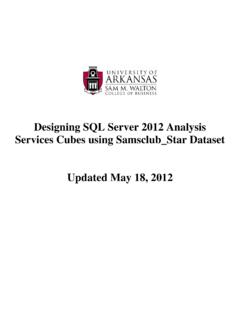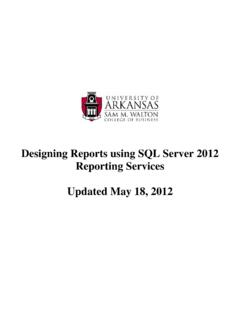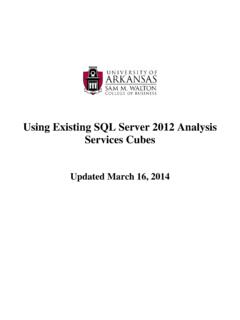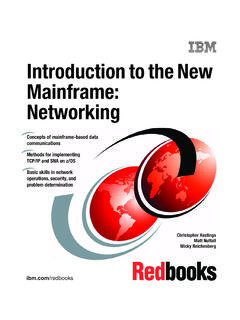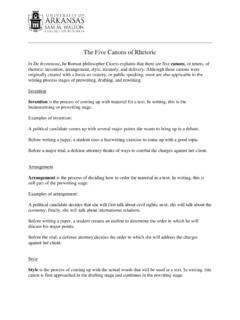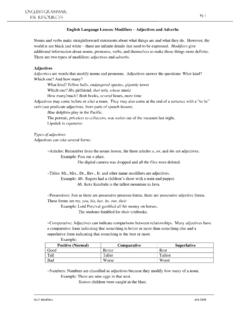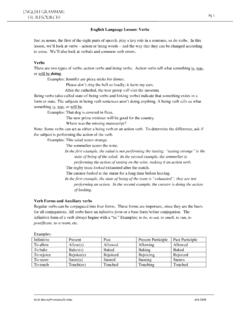Transcription of Example SQL Server 2008 Data mining - Sam M. …
1 1 data mining with SQL Server data Tools data mining tasks include classification (directed/supervised) models as well as (undirected/unsupervised) models of association analysis and clustering. 2 data mining data mining has many definitions and may be called by other names such as knowledge discovery. It is generally considered to be a part of the umbrella of tasks, tools, techniques etc. within business Intelligence (BI). Many corporate managers consider BI to be the heart of all the processes that support decision making at all levels.
2 A definition of data mining typically includes large datasets, discovering previously unknown knowledge and patterns and that this knowledge is actionable. That what is discovered is not trivial but can be usefully applied. BI and its data mining component are receiving considerable attention and fanfare as companies utilize BI for competitive advantage. Different authors may address the data mining tasks slightly different from each other but the following terminology provides a helpful and useful basis for discussing data mining .
3 The data mining tasks are: Description Estimation Classification Prediction Association analysis Clustering Description used descriptive statistics to better understand and profile areas of interest. Thus a variety of well known statistical tools and methods are used for this task including frequency charts and other graphical output, measures of central tendency and variation. data mining Tasks with a Target or Dependent Variable Estimation, classification and prediction are data mining tasks that have a target (dependent) variable.
4 Sometimes these, are referred to as predictive analysis ; however, many authors reserve the term Prediction to use of models for the future. The terms supervised and directed apply to these data mining tasks. Estimation data mining tasks have an interval level dependent target variable whereas classification data mining tasks have a categorical (symbolic) target variable. An Example of an estimation data mining task would be estimating family income based on a number of attributes; whereas a model to place families into the three income brackets of Low, Medium or High would be an Example of a classification data mining task.
5 Thus, the difference between the two tasks is the type of target variable. When either an estimation data mining task or classification task is used to predict future outcomes, the data mining task becomes one of Prediction. Again, estimation and classification are referred to as predictive models because that would be the typical application of models built for these data mining tasks. In summary, the most important concept is that estimation and classification data mining tasks require a target variable. However, the difference lies in the data type of the target variable.
6 data mining Algorithms for Directed/Supervised data mining Tasks linear regression models are the most common data mining algorithms for estimation data mining tasks. Of course, linear regression is a very well known and familiar technique. A number of data mining algorithms can be used for classification data mining tasks including logistic regression, decision trees, neural networks, memory based reasoning (k-nearest neighbor), and Na ve Bayes. 3 data mining Tasks without a Target or Dependent Variable Association analysis and Clustering are data mining tasks that do not have a target (dependent) variable.
7 Affinity analysis is another term that refers to association analysis and is typically used for market basket analysis (MBA) although association analysis can be used for other areas of study. MBA is essentially analyzing what purchases tend to be purchased together that is what items tend to have an affinity with other items. Clustering, having no target variable, algorithms attempt to put records into groups based on the record s attributes. The critical concept is that of similarity those within a cluster are very similar to each other and not similar with those in another cluster.
8 Note because these data mining tasks do not have a target variable, their corresponding models cannot be used for prediction. Thus, they are many times exploratory in nature and their results can be used downstream in predictive models. data mining Examples in this Tutorial The data mining tasks included in this tutorial are the directed/supervised data mining task of classification (Prediction) and the undirected/unsupervised data mining tasks of association analysis and clustering. Many users already have a good linear regression background so estimation with linear regression is not being illustrated.
9 Three data mining algorithms for the classification data mining tasks will be illustrated and compared: Decision Trees, Logistic Regression, and Neural Networks. Recall that classification has a categorical target variable. Association analysis and clustering are the undirected/unsupervised data mining tasks illustrated in this tutorial. The clustering algorithm is k-means. data mining overview summary data mining tasks Target Variable Typical data mining Algorithm(s) Description No Statistics, including descriptive, & visualization Estimation Yes Interval Numeric Linear Regression Classification Yes Categorical Logistic Regression, Decision Trees, Neural Networks, Memory Based Reasoning, Na ve Bayes Prediction Yes Estimation and Classification models for prediction Association analysis No Affinity analysis (Market Basket analysis )
10 Clustering No k-means, Kohonen Self Organizing Maps (SOM) 4 data mining Example using SQL Server data Tools from REMOTE Once you receive your University of Arkansas MEC account, access will be via remote desktop connection. Remote access documentation is at the following link: Once you re logged in to REMOTE you can use Microsoft s Business Intelligence Suite which provides tools that assist in all phases of business intelligence from building the data warehouse, creating and analyzing cubes to data mining . The following provides a data mining examples the data mining models illustrating classification tasks use a table of 3333 telecommunications records.
